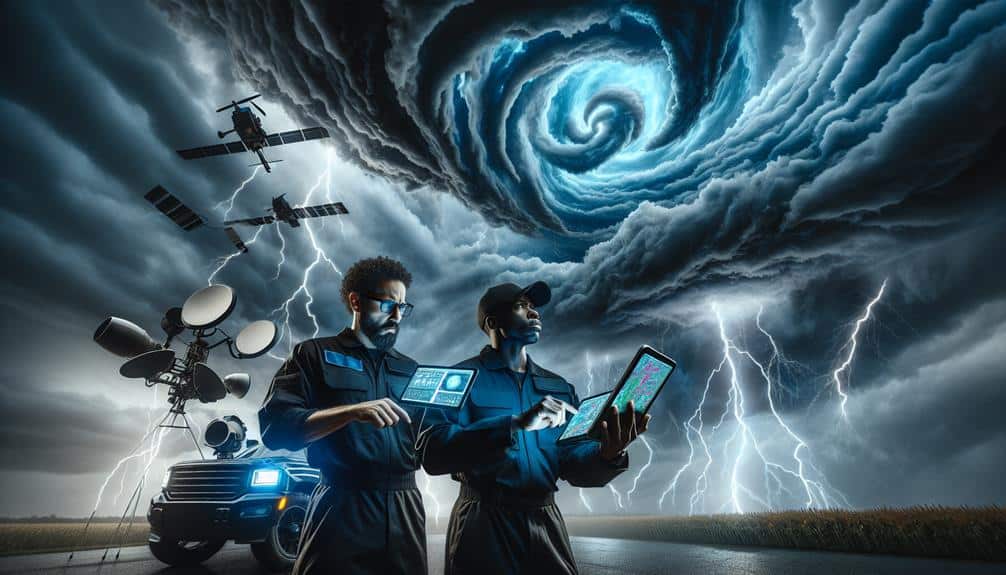We utilize GIS to integrate and analyze meteorological data for storm chasing, transforming how we predict and track severe weather. By layering datasets like satellite imagery, radar data, and temperature maps, we achieve precise spatial analysis and visualization. Advanced tools such as ArcGIS and QGIS allow us to overlay diverse data streams and monitor weather systems in real time. This enables informed decision-making, optimizes resource allocation, and enhances our ability to respond to dynamic weather conditions. Combining historical data with live weather streams and machine learning refines our models and uncovers hidden patterns, offering deeper insights into storm development and behavior.
Key Points
- GIS integrates meteorological datasets like satellite imagery and radar data for precise storm tracking and analysis.
- Real-time data visualization in GIS enables instantaneous monitoring and response to evolving weather patterns.
- Advanced GIS tools such as ArcGIS, QGIS, and GRLevel3 enhance the accuracy of storm prediction models and data interpretation.
- Layering historical and live weather data in GIS helps identify potential storm development zones and track their progression.
Understanding GIS in Meteorology
Geographic Information Systems (GIS) play an important role in meteorology by enabling the precise analysis and visualization of spatial and temporal weather data. By leveraging GIS applications, we can integrate various meteorological datasets, such as satellite imagery, radar data, and historical weather records, into a unified spatial framework. This integration facilitates in-depth spatial analysis, allowing us to identify patterns, trends, and anomalies that are essential for accurate weather forecasting.
When we employ GIS applications, we can manipulate and analyze large volumes of weather data with high spatial and temporal resolution. For instance, overlaying different data layers—such as temperature, precipitation, and wind speed—enables us to perform multi-dimensional spatial analysis. This helps in predicting weather phenomena like storms, heatwaves, and cold fronts with greater precision.
The ability to visualize data on dynamic maps enhances our understanding of meteorological processes. Spatial analysis in GIS allows us to track the movement of weather systems, assess the impact of geographical features on weather patterns, and model potential future scenarios. Through these capabilities, GIS empowers us to make informed decisions, optimize resource allocation, and ultimately, harness the freedom to navigate and respond to changing weather conditions effectively.
Key GIS Tools for Storm Chasing
When storm chasing, we rely on advanced GIS tools like ArcGIS, QGIS, and GRLevel3 to analyze real-time weather data and make essential decisions on the fly.
ArcGIS offers robust GIS mapping capabilities that enable us to layer various meteorological datasets, such as wind speed and precipitation levels, on a single interface. This integration aids in pinpointing areas of severe weather activity with high precision.
QGIS, being an open-source platform, provides extensive customization options for our storm chasing needs. Its support for numerous plugins allows us to visualize satellite imagery and radar data seamlessly. With QGIS, we can overlay topographical maps with live weather updates, enhancing our ability to navigate through challenging terrains while tracking storm developments.
GRLevel3 specializes in processing NEXRAD radar data, offering high-resolution reflectivity and velocity scans. By leveraging this tool, we get granular insights into storm structures, including mesocyclones and tornado signatures. The real-time feed from GRLevel3 is essential for making split-second decisions during storm interception.
In essence, these GIS tools empower us with the data granularity and real-time analytics needed to chase storms effectively while ensuring our safety and maximizing our observational freedom.
Data Collection Techniques
To gather accurate meteorological data, we utilize a combination of remote sensing technology, ground-based instruments, and crowdsourced reports, ensuring a thorough dataset for analysis.
Remote sensing provides us with high-resolution satellite imagery, enabling us to detect cloud formations, precipitation patterns, and temperature variances over large geographic areas. These satellite observations are essential for identifying storm development and tracking their trajectories.
Our ground-based instruments include Doppler radar systems, anemometers, and barometers, which deliver real-time data on wind speed, atmospheric pressure, and precipitation intensity. Weather balloons, equipped with radiosondes, ascend through the atmosphere to capture vertical profiles of temperature, humidity, and wind speeds at various altitudes. These measurements are crucial for understanding the atmospheric conditions that influence storm behavior.
Additionally, we leverage crowdsourced reports from storm chasers and local observers. These on-the-ground insights provide granular, localized data that often fills gaps left by remote sensing and ground-based instruments.
Analyzing Weather Patterns
Let's analyze weather patterns using GIS by focusing on historical data comparison, real-time weather tracking, and predictive pattern modeling.
We'll examine how historical datasets reveal trends and anomalies, while real-time data integration facilitates immediate weather monitoring.
Historical Data Comparison
By leveraging GIS technology, we can meticulously compare historical meteorological data to identify significant weather patterns and trends. Through advanced data mining techniques, we extract vast datasets that include temperature, precipitation, and wind speed records spanning decades. These datasets are then processed using sophisticated predictive analytics algorithms to discern patterns that could indicate rising storm severity or shifts in climate trends.
Our approach involves layering historical data on GIS maps, allowing us to visualize spatial and temporal variations in weather phenomena. This method provides a granular view of how specific regions have been impacted over time, enabling us to correlate past events with current climatic shifts. For instance, by examining historical storm tracks, we can identify regions that have experienced a marked increase in storm intensity, guiding us in understanding future risks.
Moreover, the integration of historical data with GIS facilitates the identification of long-term climate trends. This analytical process not only aids in predicting future weather events but also empowers us to develop strategies for mitigating storm impact.
As storm chasers, this data-driven approach grants us the freedom to make informed decisions, enhancing both our safety and the accuracy of our forecasts.
Real-Time Weather Tracking
Building on our understanding of historical data, we now employ GIS technology for real-time weather tracking, enabling us to analyze current weather patterns with unparalleled accuracy. By leveraging advanced weather radar systems, we can capture high-resolution data on storm behavior as it unfolds. This real-time data is essential for making informed decisions during storm chasing expeditions, particularly in dynamic and potentially hazardous environments.
Utilizing GIS-integrated navigation tools, we gain a complete view of storm trajectories and intensity. These tools allow us to overlay real-time weather data onto geographic maps, facilitating precise route planning. As we track storm cells, we can dynamically adjust our routes to avoid the most dangerous areas while positioning ourselves for ideal observation and data collection.
Moreover, GIS technology enables us to identify and analyze patterns in storm behavior in real time, providing actionable insights that were previously unattainable. By continuously updating our data inputs, we maintain a current and precise understanding of weather conditions. This capability not only enhances our safety but also maximizes the efficiency of our storm chasing operations.
Through real-time weather tracking, we transcend traditional methods, achieving a new level of operational freedom and precision.
Predictive Pattern Modeling
Harnessing the power of predictive pattern modeling, we can analyze vast datasets to identify emerging weather patterns and forecast future meteorological events with remarkable accuracy. By integrating GIS with advanced algorithms, we improve forecast accuracy, enabling us to make real-time decisions during storm chasing. Predictive modeling leverages historical weather data, satellite imagery, and real-time sensor inputs, allowing us to create robust models that anticipate severe weather phenomena.
Spatial analysis, a critical component of our approach, involves mapping weather variables like temperature, humidity, and wind speed across different geographies. By overlaying these data layers, we identify zones of potential storm development and track their progression. This spatial intelligence is pivotal for storm tracking, giving us the foresight to anticipate changes and react swiftly.
Moreover, the integration of machine learning enhances our predictive capabilities. Algorithms process massive datasets, uncovering hidden patterns and refining our models continuously. This facilitates not only immediate decision-making but also long-term strategic planning for storm chasing endeavors.
Real-Time Data Integration

Real-time data integration in GIS enables us to harness live weather data streams for enhanced meteorological analysis.
By leveraging these streams, we can achieve instantaneous data visualization, allowing for more precise and timely decision-making.
This integration greatly optimizes our ability to monitor and respond to dynamic weather conditions.
Live Weather Data Streams
Integrating live weather data streams into GIS systems allows for the continuous monitoring and analysis of meteorological phenomena in real time. By leveraging real-time data feeds, we enhance our weather forecast capabilities, enabling more accurate data interpretation and timely decision-making. These streams provide critical inputs for storm prediction models, allowing us to perform sophisticated data analysis that identifies patterns and anomalies with greater precision.
When we incorporate live weather data streams, we gain access to an extensive array of meteorological variables, including temperature, humidity, wind speed, and atmospheric pressure. This data is ingested into our GIS platforms, where it undergoes rigorous analysis to produce actionable insights. Through advanced algorithms, we can predict storm paths, intensity, and potential impact areas, notably improving our response strategies.
Our ability to analyze this data in real time empowers us to make informed decisions swiftly, ensuring we're always a step ahead. The constant flow of updated information reduces latency in our analyses, enhancing the accuracy of our storm prediction models.
Instantaneous Data Visualization
Instant data visualization allows us to dynamically interpret and display meteorological data in real time, greatly enhancing our ability to monitor weather patterns and respond to emerging threats. By leveraging Geographic Information Systems (GIS), we can integrate various data streams—radar, satellite imagery, and ground-based sensors—into a cohesive, interactive map.
This real-time monitoring capability is essential for storm chasing, as it enables us to visualize evolving weather phenomena instantaneously and make quick, informed decisions.
With GIS, we overlay diverse datasets such as precipitation intensity, wind speed, and temperature gradients, providing a multi-dimensional perspective of the atmosphere. The ability to customize these visual layers enhances situational awareness and allows us to pinpoint potential storm development zones with high precision. This immediate synthesis of data is crucial for quick decision-making, particularly in rapidly changing weather conditions.
Furthermore, GIS platforms often support predictive analytics, allowing us to project storm trajectories and potential impact zones. This proactive approach is vital for preemptive safety measures and efficient resource allocation.
In essence, instantaneous data visualization not only augments our analytical capabilities but also empowers us to act swiftly and decisively, embodying the spirit of freedom in storm chasing pursuits.
Case Studies in Storm Chasing
Examining case studies in storm chasing, we can quantify the effectiveness of GIS tools in predicting storm trajectories and enhancing data collection accuracy. By leveraging GIS, we've significantly improved our ability to track storm intensity and location in real-time.
For instance, during the 2020 Tornado Alley expedition, the integration of GIS allowed us to overlay multiple data layers, facilitating precise location tracking and timely adjustments to our chasing strategies. This approach not only optimized our data collection but also guaranteed our safety by allowing us to anticipate sudden shifts in storm paths.
In another case, during the 2021 Midwest Supercell event, we utilized advanced GIS datasets to analyze atmospheric conditions, providing crucial insights into storm intensity and potential growth. Our chasing strategies relied on these real-time analytics, enabling us to collect high-resolution meteorological data while adhering to stringent safety measures.
GIS tools enabled us to maintain a safe distance from hazardous zones, emphasizing their role in operational risk management. These case studies highlight that GIS isn't just a tool but a critical component in the science of storm chasing. Its application enhances our analytical capabilities, ensuring data integrity while prioritizing our operational safety.
Frequently Asked Questions
How Can Storm Chasers Ensure the Accuracy of GIS Data in Remote Areas?
To guarantee GIS data accuracy in remote areas, we employ data validation through remote monitoring, satellite imagery, and field observations. This methodology enhances reliability, providing freedom to make informed, real-time decisions based on precise meteorological data.
What Are the Common Challenges in Integrating GIS With Meteorological Data?
Integrating GIS with meteorological data often presents challenges like ensuring remote accuracy and seamless data integration. We must address issues of data compatibility, real-time updates, and sensor calibration to achieve reliable, actionable insights for our analyses.
How Do Storm Chasers Use GIS Data to Improve Safety Protocols?
We use GIS data to map weather patterns and track storm movements. By conducting detailed risk assessments, we refine safety protocols, ensuring we're better prepared and minimizing hazards during storm chasing. This enhances our operational efficiency and safety.
What Training Is Required for Storm Chasers to Effectively Use GIS Tools?
Sailing the storm's eye demands rigorous GIS training. We need specialized courses to master remote areas' accuracy, ensuring our data analysis is precise. Without it, we'd be sailing blind, risking safety and efficiency in the field.
How Does GIS Technology Contribute to Predictive Modeling in Storm Chasing?
GIS technology boosts predictive modeling in storm chasing by enhancing data accuracy, even in remote areas. We leverage spatial data analytics to forecast storm paths, improving our decision-making and maximizing our freedom to chase safely and effectively.

